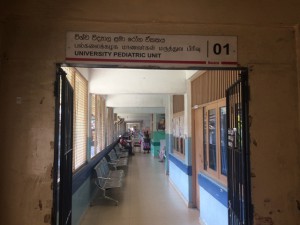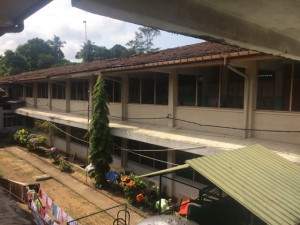The idea of a hospital being ‘at capacity’ has gained a new meaning for me since my attachment started on the Paediatrics ward at Karapitiya. This year has been particularly bad for dengue in Sri Lanka with an estimated 81, 000 dengue patients nationwide and around 250 deaths from this mosquito-borne virus.
At Karapitiya, one section of around 30 beds is almost completely occupied by children of all ages from babies to teens with dengue. One Monday alone sees over 40 children admitted to the ward leading to babies ‘top and tailing’ in cots and lanky teenagers lying with their legs from the knees down hanging off the end of their bed. But there are no complaints from any of the patients or their parents who wave fans, console any crying, feed and try to distract and entertain their sick children.
Despite these numbers, Galle has fared reasonably well compared to other regions of Sri Lanka with the dengue outbreak. I read in the newspaper about a hospital in Negombo, a town a half an hour north of Colombo that has been struggling to cope with the estimated 150 dengue patients being admitted everyday throughout June and July. The hospital director is reported as saying that resources are stretched trying to deal with the numbers of patients.
Perhaps unsurprisingly with the number of patients Karapitiya is managing, resources are also limited in the Paediatric ward. This is evident by the re-use of cannulas on the same patient over the duration of their stay. After an infusion is given, the patient’s cannula is removed, recapped and hung around the IV fluid stand, ready to reinserted for the next infusion. This situation leads to a significant number of patients receiving antibiotics for cannula site infections. This is a difficult situation to observe when it could so easily be avoided but for the cost and access to medical equipment. Particularly in Sri Lanka where it’s tropical climate can cause any infection to become serious very rapidly.
The importance of rapidly and adequately treating a tropical skin infection is taught to me by a child admitted on Wednesday morning. Seeing the symptoms of a stroke in an 18 month-old toddler is a first, and hopefully a last for me, as the left sided limb and facial weakness are features I more readily associate with being on the geriatric ward at home. But unfortunately this child had suffered a massive right hemisphere stroke after a skin infection had transformed into infective endocarditis causing a thrombus to block her right middle cerebral artery. I know the image of this child and her grieving mother will stay with me in the years to come when I’m faced with any serious infection.



1 Comment to 'At Capacity and Infections'
August 15, 2017
Dear Ursula
Thank you for your posting, reminds me so much of my own experiences in Tz paed wards… so much heart break and often so little to be done…. just a wish for clean new cannulas for all babies.
Keep writing your stories. Great to read these,
Thinking of you and your family
Kirsty (Invercargill)
Leave a comment